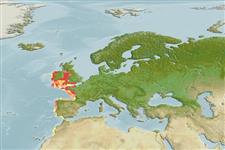Elasmobranchii (haaien en roggen) (sharks and rays) >
Rajiformes (Skates and rays) >
Rajidae (Skates)
Etymology: Raja: Latin, raja, -ae = a sting ray (Raja sp.) (Ref. 45335).
Environment: milieu / climate zone / depth range / distribution range
Ecologie
marien demersaal; diepte ? - 100 m (Ref. 4426). Temperate; 55°N - 24°N, 16°W - 1°W
Eastern Atlantic: southwestern England and Ireland to Rio de Oro in Western Sahara; absent from the North Sea and the Mediterranean.
Lengte bij maturiteit / Grootte / Gewicht / Leeftijd
Maturity: Lm 74.0, range 73 - ? cm
Max length : 87.0 cm TL mannelijk / geslacht onbekend; (Ref. 6014); max. gepubliceerd gewicht: 4.5 kg (Ref. 4699)
Dorsale stekels (totaal): 0; Anale stekels 0; Anale zachte stralen: 0. Eyes conspicuously small; dorsal fins close-set, no thorns between; upper surface predominantly spinulose, underside almost smooth in young, but head and centre of disc prickly in larger specimens; orbital thorns separate, a regular row of about 50 thorns from nape to first dorsal fin; upper surface greyish, olive to light brown with light blotches and long bands, underside white (Ref. 3167).
Found on sandy bottoms, from inshore waters to about 100 m in tidal areas (Ref. 3167). Feed on fishes (Ref. 3167). Oviparous. Distinct pairing with embrace. Young may tend to follow large objects, such as their mother (Ref. 205). Eggs are oblong capsules with stiff pointed horns at the corners deposited in sandy or muddy flats (Ref. 205). Egg capsules are 6.6-10.0 cm long and 4.1-6.3 cm wide (Ref. 41250). About 54-61 eggs are laid by an individual in a year (Ref. 41250).
Oviparous (Ref. 3167). Paired eggs are laid. Embryos feed solely on yolk (Ref. 50449). Distinct pairing with embrace. Young may tend to follow large objects, such as their mother (Ref. 205).
McEachran, J.D. and K.A. Dunn, 1998. Phylogenetic analysis of skates, a morphologically conservative clade of elasmobranchs (Chondrichthyes: Rajidae). Copeia 1998(2):271-290. (Ref. 27314)
Status op de Rode Lijst van het IUCN (Ref. 130435)
Gevaar voor de mens
Harmless
Gebruik door de mens
Visserij: van minder commercieel belang; sportvis: ja
Meer informatie
ReferentiesAquacultuurAquacultuurprofielKweeklijnenGeneticaElectrophoresesErfelijkheidZiektesVerwerkingNutrientsMassaconversie
Tools
Speciale rapporten
Download XML
Internetbronnen
Estimates based on models
Preferred temperature (Ref.
123201): 10.4 - 15.4, mean 12 °C (based on 138 cells).
Fylogenetische diversiteitsindex (Ref.
82804): PD
50 = 0.5000 [Uniqueness, from 0.5 = low to 2.0 = high].
Bayesian length-weight: a=0.00468 (0.00297 - 0.00738), b=3.30 (3.17 - 3.43), in cm total length, based on LWR estimates for this species & Genus-body shape (Ref.
93245).
Trofisch niveau (Ref.
69278): 3.9 ±0.2 se; based on diet studies.
Weerstandsvermogen (Ref.
120179): laag, minimale populatieverdubbelingstijd 4,5-14 jaar (Fec= 54-61).
Fishing Vulnerability (Ref.
59153): Moderate to high vulnerability (55 of 100).
Climate Vulnerability (Ref.
125649): Very high vulnerability (88 of 100).
Nutrients (Ref.
124155): Calcium = 6.33 [0.91, 111.73] mg/100g; Iron = 0.25 [0.02, 2.91] mg/100g; Protein = 17 [14, 19] %; Omega3 = 0.847 [0.342, 2.086] g/100g; Selenium = 10.4 [2.2, 54.2] μg/100g; VitaminA = 6.1 [0.5, 70.5] μg/100g; Zinc = 0.354 [0.024, 3.858] mg/100g (wet weight); based on
nutrient studies.
